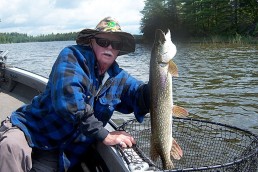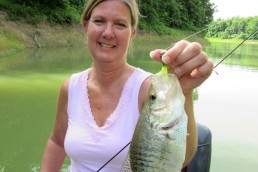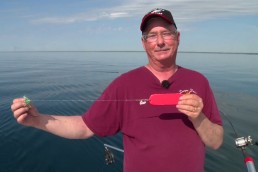Prime Time Spring Pike
SHARE THIS POST
Esox lucius, by their very makeup, look like the pugnacious predators they are. Because they seem to leave caution to the wind, you might say that they are user-friendly to fishermen. In shallow waters in the spring, northern pike, especially at 30 to 40 inches, are easier to find and catch—until they disappear.
Spring pike are usually seen and caught as they are setting up in marshy areas, tributaries, and other shallow, weedy areas in a pre-spawn mode. They eat voraciously to build up strength and endurance for the rigors of spawning. When the water temperature hits the mid-40s, they spawn.
Pike or northern pike are one of Michigan’s first fish to spawn. Let’s call spawning the actual mixing of eggs and milt. Some new anglers can get mixed up telling the difference between a pike and a muskie too. Both species have long, thin bodies and pointed snouts as newborns, but pike typically have light, bean-like spots on a dark background. Muskies usually have dark stripes or spots on a light background. My daughters, Lorri and Coleen, went out in my boat one day and caught a couple of pike, which turned out to be small muskies—uh-oh. Well, I told them about the differences and also that the tail fins on a pike are usually rounded while the tail fins on a muskie are usually pointed.
Hammer handles to trophies
Pursuing pugnacious pike in the spring is a terrific way to get acclimated to boat fishing. Prior to or just after ice leaves the main lake, spawning occurs. However, this is a benchmark and it also depends on the weather and the type of lake.
Concentrating on current and funnel areas is a good way to start pike fishing. Then, search major structure such as points, reefs, channel edges and old weedlines. But sooner or later, pike will move from areas in close proximity to the main lake and swim progressively to warmer, shallower water in the big bays and then into smaller bays, backwaters and creeks. Check for snowmelt and start fishing nearby. Mid-April and into May is usually prime time. Check your Michigan Fishing Guide for information on opening days, etc.
Recently, I was thinking how I went about muskie fishing in fall. I began by fan casting and soaking a sucker as I drifted along—why didn’t I use a use a dual approach for pike, especially for big pike in spring? Pike are voracious eaters during the spawning period, and pike, especially large ones, are cold-water fish. When water temperatures rise as summer comes around, they will begin to migrate to deeper, cooler water and leave the shallows, making them more difficult to catch.
Early in June for Canadian fishing trips, we have caught nice walleyes in the morning or evening. And in between, we went pike fishing. Pike are usually fun because you become addicted to the fast action; you can catch hammer handles and a few “keepers” on almost every cast. But I got smarter—we trolled or cast in deeper, cooler water for bigger trophy pike. Pike in the 30- to 40-inch sizes went on the stringer, and occasionally the 50-inch mark was broken.
Casting and dead bait
Are you enjoying this post?
You can be among the first to get the latest info on where to go, what to use and how to use it!
We used several lures, including diving Rapalas, spinnerbaits and walk-the-dog baits that slither from side-to-side triggering larger pike and walleyes. But if I wanted to use one lure all day, I would pick a white spinnerbait. We were more successful with weighted spinnerbaits too, especially ones that had a 3/8-ounce jig on the front. But the Reefhog glider-type bait has been my favorite for all-around super strikes.
Quick-set rigs and dead bait
The one thing I have to remember about spring pike fishing is that big pike are not stupid. Whether on heavily pressured lakes or remote lakes, I use a dual approach.
There is really nothing better than stealthily creeping into a small bay with my trolling motor on a cloudy, balmy spring day. I have a medium-heavy, muskie-casting rod filled with braided line. I tie on 5 feet of 50-pound line. Seaguar’s Blue Label fluorocarbon leader line attached with 20-pound-test Cortland Toothy-Critter Tie-Able wire works well. I use a loop knot to tie on the wire in an “upside Y” fashion. This goes on the sides of the dead sucker or smelt.
Now you can fan cast, and put some brine on your dead bait to preserve it. And put colored dye on the dead bait and add scent. There are dyes made specifically for dead baits. Moving slowly along and casting with a spinnerbait, you can watch as a pike comes in like a rocket—pike eat the dead stuff.
Tips
Using a Thill Big Fish slip bobber can be a big help, especially if you position yourself in shallow waters at 2 feet. You will keep track of your dead bait more easily and can use the bobber as a strike indicator.
Throwing big spinnerbaits like Lindy’s 1-ounce M/G Muskie Tandem along with big Colorado blades, attracts and triggers big pike rather than the skinny snakes. Small lures do work in spring too it is said, but trying bigger lures is certainly a good idea, especially after the spawn and especially when spring rains make for dirty water. And spring run off rains can cause cloudy water. And big spinnerbaits in the muskie tackle range provide vibration, noise and sparkle.
Finally, a 4- to 5-inch paddle tail swimbait is a lure not many guys would try in the spring, but a 3/8-ounce bullet-head jig in 10 feet of water or less might be a good choice. And, of course, when you want to slow down for sluggish pike in the spring, 1/4 ounce or less is a good choice.
Let’s let the pike tell us what they want, and we’ll offer them their preferred meals. Because, a nice pike filleted in the old “five-piece” way is a grand meal.
MWO
SHARE THIS POST
Did you enjoy this post?
You can be among the first to get the latest info on where to go, what to use and how to use it!
Robert Dock Stupp
MidWest Outdoors works with more than 200 outdoor experts each year, who contribute articles based on their areas of expertise. MidWest Outdoors magazine offers more fishing and hunting articles than any other publication!



